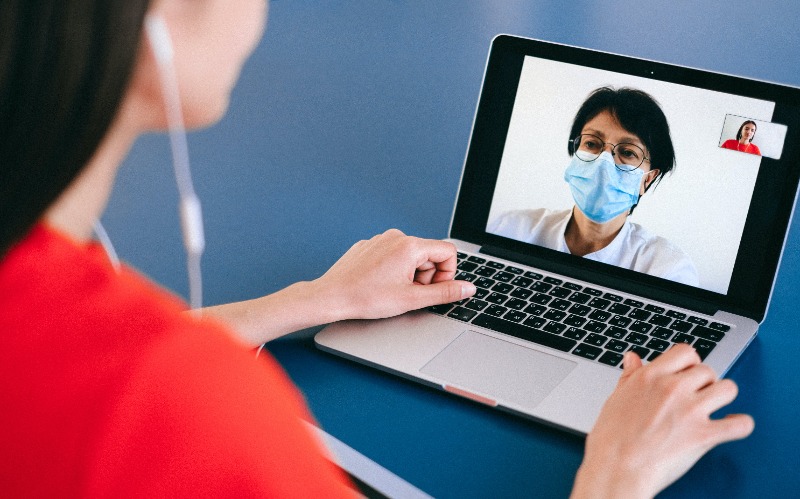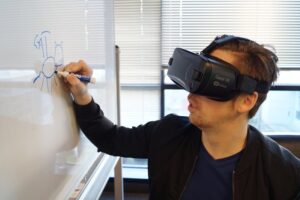Have you ever imagined how wonderful it would be to go inside your body’s 3D model with your doctor during a video call right from your home? No, it is not a scene out of a Hollywood movie or a sci-fi novel. With technologies like AR (augmented reality) and VR (virtual reality) integrated with telemedicine, it is entirely possible today.
Jointly called Extended Reality (XR) technology, these immersive technologies can create virtual environments and combine them with reality. VR immerses users in a virtual world, while AR overlays virtual elements onto the real world for improved context.
The future of healthcare is arriving through our screens, and it’s highly immersive and transformative. It allows doctors to conduct consultations, examinations, and even surgeries remotely. The introduction of AR and VR into telehealth services is set to revolutionize healthcare. More than 25% of hospitals in the U.S. and Germany already use AR/VR software for increased efficiency.
The potential benefits of integrating AR and VR into telehealth are vast, from enhanced patient care to training clinicians. These technologies improve diagnosis, enhance access, reduce costs, and improve the quality of healthcare.
Sooner or later, the use of AR/VR in telehealth is poised to disrupt the entire healthcare industry and usher in a new era of patient-centric, cutting-edge healthcare.
How AR and VR Can Improve Access to Healthcare
Delivering Healthcare in Deprived Regions
With higher death rates due to leading causes, people living in rural areas are more susceptible to healthcare issues than their urban counterparts.
Telehealth is a blessing for such people. It reduces barriers to healthcare for those living far from specialists or having time, transport, or mobility limitations. It helps with communication, counseling, chronic disease monitoring, and more, which enhances life quality, cuts hospitalization, and reduces deaths.
Several organizations run telehealth programs for the underprivileged. For instance, the CDC promotes nationwide telehealth initiatives to improve rural residents’ access to chronic disease prevention, management, and specialist care.
Furthermore, a review of 15 studies revealed positive outcomes of rural telehealth: increased satisfaction, convenience, and cost savings. It also boosted resource utilization, physician recruitment, and guidance.
Medical Training and Support
Not only for the patients, the XR technology is also a boon for healthcare professionals. It enhances medical training quality, lowers costs, and improves retention. It allows students to practice physical skills like inserting a catheter and taking blood samples in immersive environments, enhancing precision and learning.
In addition, the AR/VR tech aids practical training for surgical procedures with pre-surgery practice and simulations. Through sensor synchronization, AR apps create patient body simulations, improving medical testing and accessibility for practitioners.
Many universities have incorporated this technology into their medical training. For example, Ohio State University College of Medicine has designed a hi-tech system with virtual disasters to train physicians and first responders to deal with emergencies.
Dr. Nicholas Kman, a professor at the college, confidently says, “…once you put that headset on you are immersed into a scenario where you can move around, interact with victims, and make life-saving decisions.”
How AR and VR Can Reduce Healthcare Costs
Healthcare often comes with the additional cost of travel and accommodation. With AR and VR, consultations and follow-ups can be done remotely. It saves the patients from doling out hefty amounts for long commutes and expensive stays.
VR also considerably reduces medical education costs. For example, US elderly care facilities spend $3,000 per employee on traditional tracheal insertion training. But, Next Galaxy has developed VR software that reduces training costs to $40 per employee.
Utilizing these technologies, healthcare providers can maximize resource utilization, trim expenses linked to conventional healthcare, and streamline operations. It results in substantial cost savings for both the professionals and patients.
How AR and VR Can Improve the Quality of Healthcare
Patient-Centric Care
Virtual Reality (VR) can transform patient experiences by creating immersive environments that help in psychological therapy, mental health diagnosis, and treating anxiety and ADHD.
VR’s immersion also reduces patient anxiety during examinations and surgeries, enhancing the quality of care. In a St George’s Hospital (London) pilot study, patients wore VR headsets before and during surgery. Feedback was very positive: 100% had a better hospital experience, 94% felt more relaxed, 80% had less discomfort, and 73% were less worried about the headset.
Augmented Reality (AR) is equally impactful, offering physicians visual overlays to improve diagnosis and treatment. AR headsets allow practitioners to operate hands-free and connect with specialists when required.
Cultivating Precision in Real-Time
Augmented Reality (AR) and other extended reality (XR) technologies can also transform real-time procedures.
In surgery, AR-based devices like Hololens can remotely enhance surgeons’ precision by providing real-time vitals, equipment locations, and organ visualization. This expedites procedures, maintains safety, and enhances doctors’ decision-making during critical operations, such as TAVI heart procedures.
Challenges and Barriers to the Adoption of AR and VR in Telehealth
Using XR in telehealth has the potential to transform healthcare. However, like every new technology, it has its own set of challenges.
The AR/VR technology in medicine is still in R&D and requires 5G (or 6G) networks besides expensive hardware such as fast computers and graphic cards, expensive sensors, HD recording instruments and displays, and specialized devices. It makes the lack of funding a constant hurdle. However, as mass adoption increases, bulk production of the devices can solve this issue.
While AR/VR technology can enhance patient experiences and outcomes, some patients lack access to devices or tech literacy necessary to fully realize its benefits. The challenge of ensuring equal access to AR/VR-based healthcare can be addressed by running awareness programs among underserved citizens and providing them with affordable devices with usage guidance.
Moreover, since healthcare is heavily regulated, technologies like AR/VR are laden with stringent privacy and security mandates like HIPAA and GDPR. Even insurance regulations make it challenging for patients to claim reimbursement due to the lack of a standard billing code for AR/VR-based care. But as more people use telehealth and awareness expands, regulators will need to update their protocols to make AR/VR care more accessible.
A Glimpse Into the Future
The future of AR and VR in telehealth holds immense promise. These technologies can significantly improve healthcare access, cut costs, and boost care quality. It’s a future where
- Quality healthcare knows no distance
- Personalized treatments are the norm
- Doctors are trained with precision
As we move forward, it’s essential to be open-minded about the potential of AR and VR in telemedicine. These innovations can disrupt traditional healthcare, paving the way for personalized, tech-enhanced care benefiting patients and providers. They promise global collaboration, healthcare democratization, and cost reduction.
We must further explore the possibilities and learn how the adoption of AR and VR can impact the healthcare industry as a whole. The future of healthcare is not a dream; it’s a new reality, and it’s happening right now.










